Economic Record: President Clinton
|
 |
||||||||||||||||||||||||||||
The economy performed phenomenally during President Clinton's two terms. He came in well above average according to every one of the measures below and he has the best record for job creation of all time. He is the only one of the five most recent presidents to have reduced the debt as a percentage of GDP. Major economic events:
| |||||||||||||||||||||||||||||
GDP | |||||||||||||||||||||||||||||
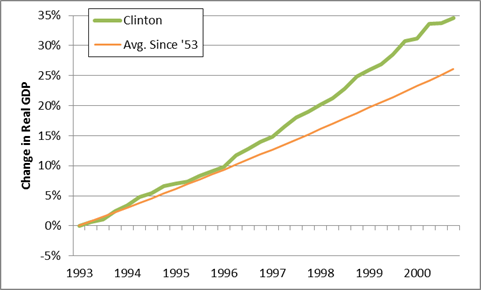 Related: Best Presidents for GDP growth Source: BEA Data: Excel | The green line represents the GDP growth during the presidency of President Clinton. The orange line reflects
the average rate of GDP growth since 1953. The period from 1991 to 2001 is the longest sustained period of economic growth since WW2 and the bulk of it occurred during Clinton's presidency. | ||||||||||||||||||||||||||||
| | |||||||||||||||||||||||||||||
Job Creation | |||||||||||||||||||||||||||||
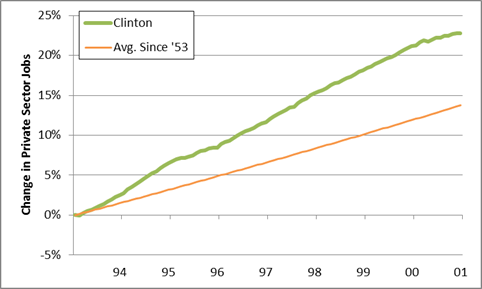 Related: Ranking the presidents for job creation Source: BLS Data: Excel | The green line represents the rate of the growth in the number of jobs under President Bill Clinton. The orange line reflects
the average rate of growth in the number of jobs since 1953. More jobs were created during the Clinton presidency than during any other presidency in American history. That is not an entirely fair comparison. Because the population continually increases, presidents significantly further back in history cannot compete with modern day numbers. Adjusted for population, FDR would hold the title. But, Clinton's job creation numbers are nonetheless incredible. | ||||||||||||||||||||||||||||
Median Income | |||||||||||||||||||||||||||||
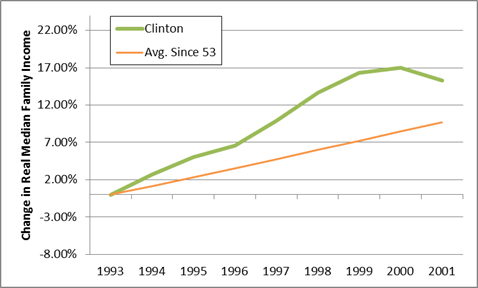 Related: Ranking the presidents for income growth Source: Census Data: Excel | The orange line is the rate at which the median family income has increased on average since 1953 and the
green line is how fast it increased under Clinton. | ||||||||||||||||||||||||||||
| | |||||||||||||||||||||||||||||
Debt as a Percentage of GDP | |||||||||||||||||||||||||||||
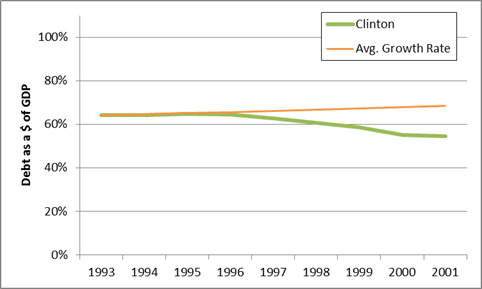 Related: Change in debt by president Source: BEA Treasury Data: Excel | This graph examines the way the debt shifted relative to GDP. The orange line shows
what the debt would have been if it had started at the same level as it was at when President Clinton took
office and had grown at the average rate. The green line shows what actually happened. Clinton is the only one of the five most recent presidents to have reduce the debt as a percentage of GDP over his entire term and he is the only president since the 1960s to have run a budget surplus. | ||||||||||||||||||||||||||||
Stock Market | |||||||||||||||||||||||||||||
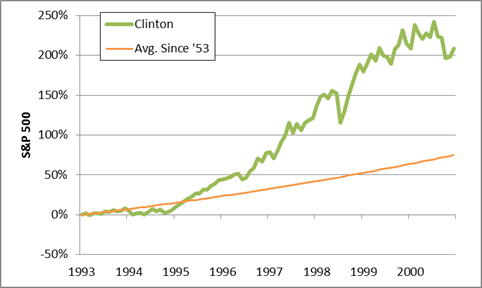 Related: Stock market performance by party of president Source: Yahoo Data: Excel | This graph compares the performance of the S&P500 under President Clinton with the average. The remarkable stock market growth during the Clinton presidency was principally driven by the dot-com boom, which peaked with the purchase of Time Warner by AOL in January of 2000. Shortly thereafter, the market began to fall, although the worst of the crash occurred during the presidency of George W. Bush. | ||||||||||||||||||||||||||||
Compared to Other Developed Countries | |||||||||||||||||||||||||||||
 Related: Economic performance relative to NATO countries Source: USDA University of Groningen Data: Excel | This shows how the GDP growth of the United States compared to the GDP growth in the other original NATO member countries.
The other original NATO member countries are used as a benchmark because they have had relatively similar economic status to the
United States during the entire period examined. The U.S. economy solidly outperformed the other original NATO members during Clinton's two terms. Bill Clinton ranks third since WW2 in this regard. | ||||||||||||||||||||||||||||
President Clinton's economic success was nearly unparalled. However, one of the major drivers was beyond his control- the dot-com boom. Nonetheless, President Clinton certainly made the most out of the opportunity and took the economy to new heights. Clinton struck a number of compromises with Republicans in the legislature that resulted in a relatively moderate set of policies. For example, he accepted the Republican demands for lower capital gains taxes and a drastic reduction in welfare spending, but he made those concessions in exchange for an increase in the minimum wage and a dramatic increase in the Earned Income Tax Credit. | |||||||||||||||||||||||||||||
|
January 4, 2018 | |||||||||||||||||||||||||||||





